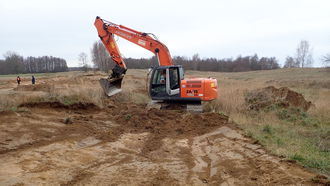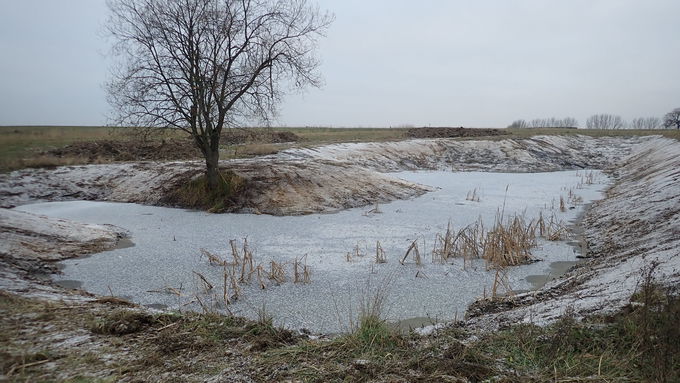Profiling of the waterbodies. © Thomas Kutter, NLWKN
download picturemain content
Project of the month
#04/2020 UPGRADING OF HABITATS FOR THE NATTERJACK TOAD AND THE COMMON SPADEFOOT TOAD
Dredging for the toads in the natural heritage site ‘Herzogsberge’
The DBU natural heritage site ‘Herzogsberge’ is located near Cremlingen southeast of Braunschweig and covers an area of 127 hectares. The property has been assigned to DBU Natural Heritage Limited Liability Company in 2016. The natural heritage subsidiary of the German Federal Enironmental Foundation (Deutsche Bundesstiftung Umwelt - DBU) in Osnabrück has been entrusted with around 70,000 hectares of former military sites throughout Germany in trust to secure and maintain these valuable habitats. The natural heritage site near Cremlingen is included in the nature reserve ‘Herzogsberge’ which was designated in July 2019. The largest part of this area is also included in the SAC ‘Wälder und Kleingewässer zwischen Mascherode und Cremlingen’.
The spacious areas of open land of the former military training ground have been used extensively for decades. Small areas of sandy grassland, open soil areas, small excavation pits, reed beds, permanent and temporary standing waters, natural watercourses and smaller wooded areas are scattered like a mosaic in the open land areas. Due to the nutrient deficiency of the soils and the structural diversity, there is a large number of endangered animal and plant species living here. Due to the former intensive military use, numerous small water bodies have developed at a total of five sites, which are home to the crested newt (Triturus cristatus), the natterjack toad (Bufo calamita), the common spadefoot toad (Pelobates fuscus) and the moor frog (Rana arvalis), for example. After the abandonment of military use in 2003, the conditions for many amphibian species became worse due to the rapid succession of the waterbodies. Especially pioneer species such as the natterjack toad and the common spadefoot that depends on sandy soils, suffer from this situation as they find it difficult to find suitable spawning waters.
The action which was implemented as part of the LIFE IP Atlantic Region DE in November and December 2018 by the Lower Saxony Water Management, Coastal Defence and Nature Conservation Agency (NLWKN) in cooperation with the DBU and the Lower Nature Conservation Authority of the district of Wolfenbüttel, therefore aimed to stabilise the populations of both species in this area. To achieve this, small water bodies were constructed and existing ones were restored, and areas of immature soil with diggable grounds were created. Only a sufficient supply of pioneer habitats can preserve the population of the natterjack toad in the medium to long term. The works were preceded by an intensive survey of the species and planning by the consultant and biologist Manfred Wenst who has been in charge of the area since the late 1980s. The Lower Nature Conservation Authority had last restored the small water bodies in 2014 with funds from the federal state of Lower Saxony.
The five water body locations are located within a radius of about one kilometre. In all five locations, call activities of the natterjack toad had been recorded during the surveys in 2019. Between the beginning of May and mid-June, spawning was observed several times. Presumably up to four generations managed to go ashore.
The occurrence of the common spadefoot was not verified in 2019. However, in the current investigations in 2020 their presence has again been documented by calls and spawning.
Related Topics
Further Links
- SAC ‘Wälder und Kleingewässer zwischen Mascherode und Cremlingen’ – Bundesamt für Naturschutz (in German) (external link opens in a new window)
- Nature Reserve ‘Herzogsberge‘ - Lower Saxony Water Management, Coastal Defence and Nature Conservation Agency (NLWKN) (in German) (external link opens in a new window)
- DBU Natural Heritage Site ‘Herzogsberge’ (in German) (external link opens in a new window)
- District of Wolfenbüttel, Department 670 Nature and Landscape Protection (in German) (external link opens in a new window)





